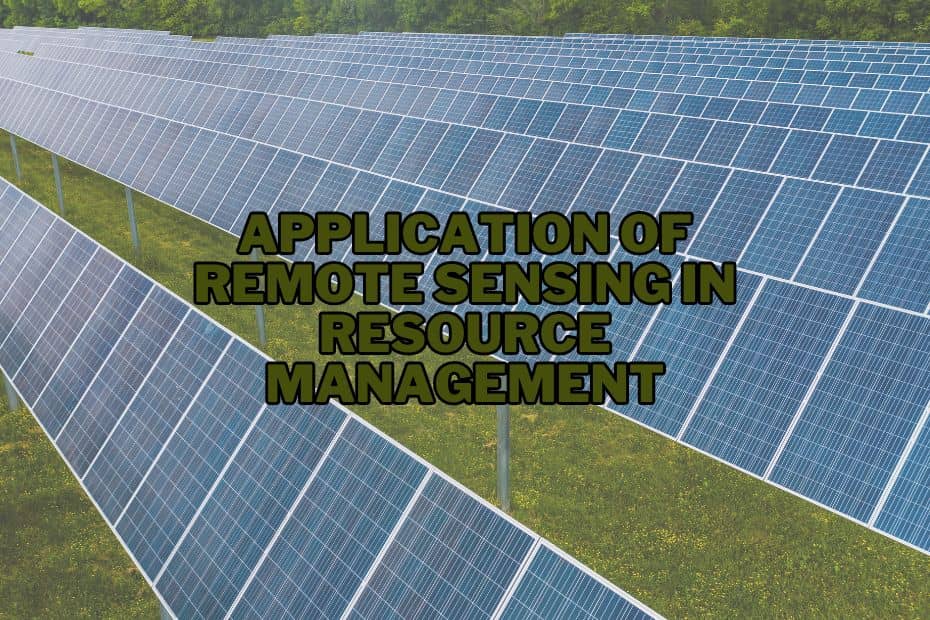Resource management is a critical component of sustainable development and environmental preservation. Over the years, the integration of remote sensing technology has revolutionized the way we monitor and manage various resources, leading to more efficient and data-driven decisions. In this comprehensive guide, we will delve into the myriad application of remote sensing in resource management.
Remote sensing is a versatile technology used in resource management across various sectors. It helps monitor and optimize agriculture, forestry, water resources, urban planning, disaster response, energy management, and more. By providing real-time data and insights, remote sensing enables informed decisions for sustainable resource utilization and conservation.
Application of Remote Sensing In Resource Management
Remote sensing involves the collection of data from a distance, typically through satellites, aircraft, or drones. This technology has proven to be a valuable tool in managing various resources efficiently and sustainably. Let’s explore its applications in detail.
1. Agricultural Land Monitoring
Remote sensing plays a pivotal role in modern agriculture. Satellites equipped with multispectral sensors capture valuable data on crop health, soil moisture levels, and land usage. By analyzing this data, farmers can optimize irrigation, fertilization, and pest control strategies, leading to increased crop yields and resource efficiency. Moreover, remote sensing aids in early detection of crop diseases and pests, allowing for timely intervention and reduced yield losses.
2. Forest Management
Forests are essential for biodiversity conservation and carbon sequestration. Remote sensing enables forest managers to monitor forest cover, assess deforestation rates, and track illegal logging activities. It also aids in wildfire detection and management, helping to protect valuable ecosystems and mitigate the impact of forest fires on resources.
3. Water Resource Management
Effective management of water resources is crucial for sustainable development. Remote sensing assists in monitoring water bodies, including lakes, rivers, and reservoirs, providing valuable data on water quality, levels, and pollution. This data informs decision-makers on allocation and conservation efforts, ensuring a reliable and clean water supply for communities.
4. Urban Planning and Development
As urbanization continues to expand, efficient urban planning becomes paramount. Remote sensing supports city planners in land-use mapping, infrastructure assessment, and population density analysis. This information aids in the development of sustainable cities, reducing resource strain and improving the quality of life for urban residents.
5. Disaster Management
In times of natural disasters such as hurricanes, floods, or earthquakes, remote sensing offers critical support for disaster management. Satellite imagery provides real-time data on the extent of damage, enabling rapid response and resource allocation. This technology saves lives and minimizes the economic impact of disasters.
6. Energy Resource Management
Remote sensing contributes significantly to energy resource management. It assists in locating and monitoring renewable energy sources such as solar and wind farms. Additionally, it aids in the inspection of pipelines and power lines, ensuring efficient energy distribution and minimizing resource wastage.
7. Climate Change Monitoring
Climate change is a global concern that affects various resources, from water to agriculture. Remote sensing provides essential data for climate modeling, tracking temperature changes, sea-level rise, and ice cap melting. This information informs policymakers and enables proactive measures to mitigate the impact of climate change on resources.
8. Wildlife Conservation
Conserving biodiversity is essential for maintaining ecological balance. Remote sensing helps in monitoring wildlife habitats, tracking animal migrations, and detecting illegal poaching activities. This technology empowers conservationists to protect endangered species and their natural habitats.
9. Mining and Mineral Exploration
The mining industry relies on remote sensing for efficient resource exploration. Satellites equipped with advanced sensors can identify mineral deposits, assess their composition, and monitor mining operations‘ environmental impact. This aids in responsible resource extraction and reduces ecological damage.
10. Coastal Zone Management
Coastal zones are vulnerable to erosion, pollution, and rising sea levels. Remote sensing provides valuable information for coastal zone management, including shoreline changes, water quality, and the monitoring of coral reefs. This data is crucial for preserving coastal resources and protecting coastal communities.
11. Soil Erosion Control
Preventing soil erosion is vital for maintaining fertile agricultural land. Remote sensing helps identify erosion-prone areas and assess the effectiveness of erosion control measures. This technology enables sustainable land management practices that preserve soil resources.
12. Infrastructure Monitoring
Infrastructure, such as roads, bridges, and buildings, requires regular maintenance. Remote sensing aids in infrastructure monitoring by detecting structural weaknesses, assessing damage after natural disasters, and ensuring safe and efficient resource allocation for repairs.
Conclusion:
In conclusion, the application of remote sensing in resource management is a powerful tool that enhances our ability to monitor and protect valuable resources. From agriculture to infrastructure, this technology provides critical data that informs decision-making and supports sustainable development. As we continue to face environmental challenges, the integration of remote sensing will play a pivotal role in ensuring the responsible and efficient management of our planet’s resources.
FAQs: Application of Remote Sensing In Resource Management
What is the role of remote sensing in agriculture resource management?
Remote sensing helps in agriculture by monitoring crop health, detecting disease outbreaks, assessing soil conditions, and optimizing irrigation, ultimately enhancing crop productivity and resource efficiency.
Can remote sensing be used for water resource management?
Yes, remote sensing is crucial for water resource management. It aids in monitoring water quality, detecting pollution, assessing water availability, and managing watersheds and reservoirs effectively.
How does remote sensing contribute to mineral resource exploration?
Remote sensing is valuable for mineral resource exploration as it can identify geological features, mineral deposits, and the composition of the Earth’s surface, helping mining companies target areas with potential mineral resources.
What are the applications of remote sensing in wildlife conservation and natural resource protection?
Remote sensing supports wildlife conservation by tracking animal populations, monitoring habitat changes, and combatting illegal activities like poaching, ultimately aiding in the protection of natural resources.
